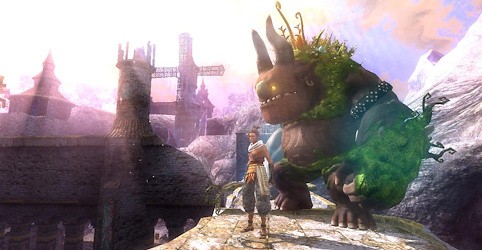Majin and the Forsaken Kingdom

by Chris Priestman
reviewed on PS3
Recycling
It is no accident that Majin and the Forsaken Kingdom fell into my lap as of late. With fans of Team Ico heavily anticipating the release of their third title, Game Republic have done well to appease our curiosities for a brief moment with this oddly similar looking game. However, this is definitely not a Team Ico game, and although it invites so many comparisons, it is of an entirely different breed. In fact, it plays more like a Japanese Jak and Daxter in many regards. After all, the story boils down to the journey of a man and his pet attempting to revert the evil that has overtaken a land. Originality may not be Majin’s strong point, but what can Yoshiki Okamoto of Resident Evil and Street Fighter fame achieve with a simple tale of good and evil?
Of Myths And Legends
The idea behind Majin and the Forsaken Kingdom originates from Japanese mythology and children’s stories – it focuses on the friendship and bravery of the hero and the magical beast. The term ‘Majin’ means genie or sorcerer in Japanese, but it can also refer to an evil entity. This dual meaning actually serves as quite a useful insight into the Majin in the game as he is a herbivorous dog-like creature with plants growing over him, but also holds a reliance in the darkness as a source of food. The Majin is actually called Teotl and he is the guardian of the kingdom that he inhabits. Playing as a nameless thief, you come across the Majin in the kingdom’s castle and free him from the imprisonment that the dark forces have enforced upon him. Upon escaping the castle, the new-found duo is not able to re-enter as four dark masks seal the door. The rest of the game has you travelling across the land to defeat the four dark generals who wear the corresponding masks. Upon defeating each general, part of the castle door seal is broken and more areas are unlocked that lead to the next general. The eventual goal is to re-enter the castle in order to destroy the origin of the darkness.
This layout of the plot sounds linear and it is indeed very much so. Despite the impression the game gives from its artwork, it is not spacious at all even though it is set in a vast land. In fact, when you are wandering the various locations the game has to offer, you may as well be inside a dungeon. The game is full of corridors, and the areas that do open up a slight bit more are always closed abruptly with a large mountain or similar structure. This is a game without a horizon. However, it is very bright and colourful so it is hardly a drab experience despite its constrictions. And in actual fact, the game is quite satisfying as each area can be completed fully and then you can move on knowing you have left nothing behind.
Missing a Piece
I am guessing the appeal to the majority of players drawn to this game is going to be the puzzle element - and quite rightly so. There are a number of interesting puzzles to solve but admittedly they are not too hard. The only times I really got stuck were when I simply did not see an extra area or a required item, so it was simply misguidance. If you do genuinely get stuck, though, you can always consult the omnipresent assortment of animals that are there to help you or warn you of an upcoming danger. Mostly, I was able to quickly work out the puzzles and was never astounded by their complexity, but I still found them pretty fun.
The most interesting aspect of the puzzles is when you have to use the Majin’s various magical powers. These are mainly elemental powers that are gained by having the Majin eat the fruit that contains his previously lost power. There is a new one to be found in each of the five unique locations and so every different place you travel to will have a fresh set of challenges to solve. Along with the new power to be gained, each area will offer different interactive objects such as bombs, pendulums or generators that correspond to the newly acquired power.
As a thief who was raised by animals in a wood, Tepeu can talk to the aforementioned animals as well as the Majin. Tepou can therefore give the Majin commands to carry out actions that only something of his size is capable of. Often you will climb on his back to reach a higher area, have him prepare a trebuchet or suck up a gallon of water for various uses.
There are a few problems with the platforming sections, however. They simply do not feel natural, and sometimes the game will not allow you to hang on to certain areas because you are not supposed to and thus draw away from the freedom in the game. On the other hand, the command system is quite outstanding in its simplicity and can rarely be accused of any inaccuracy. The partnership element therefore work really well as you use the Majin in solving some really diverse puzzles.
7.0
fun score
Pros
Sprightly and charming, the partnership works well, combat is quite innovative, constant sense of achievement.
Cons
Lacks space and a sense of freedom, can get a little repetitive, not much replay value, very linear and a little too familiar.







